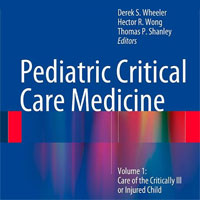Tag: pediatrics
Critical Pediatric Heart Deaths Drop by 24% at Hospitals With Cardiac ICUs
Major complications fall by 12%, time on a ventilator declines by 13% among children in the cardiac ICU at PC4 hospitals As a pediatric cardiology fellow nearly a decade ago, Michael Gaies remembers asking hospital colleagues... read more
An Ethical Claim for Providing Medical Recommendations in PICU
The Declaration of Geneva was recently revised to emphasize patient autonomy and the importance of clinicians sharing medical knowledge. This reflects the welcome evolution of the doctor-patient relationship from one... read more
Pediatric Critical Care Medicine: Care of the Critically Ill or Injured Child
The second edition of Pediatric Critical Care Medicine spans three volumes, with major sections dedicated to specific organ systems. Each major section consists of separate chapters dedicated to reviewing the specific... read more

Probiotics for the Prevention of Antibiotic-associated Diarrhea in Children
Antibiotic-associated diarrhea (AAD) occurs when antibiotics disturb the natural balance of "good" and "bad" bacteria in the intestinal tract causing harmful bacteria to multiply beyond their normal numbers. The symptoms... read more
Risk for Mortality in Critically Ill Children Needing RRT
Margaret M. Parker, MD, MCCM, speaks with Danny Hames, MD, on his article titled "Risk Factors for Mortality in Critically Ill Children Requiring Renal Replacement Therapy" published in the November 2019 issue of Pediatric... read more
Healthcare Provider Perceptions of Cardiopulmonary Resuscitation Quality During Simulation Training
Cardiopulmonary resuscitation performance during mock codes does not meet the American Heart Association's quality recommendations. Healthcare providers have poor insight into the quality of cardiopulmonary resuscitation... read more
Sedation, Sleep Promotion, and Delirium Screening Practices in the Care of Mechanically Ventilated Children
The results highlight the heterogeneity in sedation practices among intensivists who care for critically ill children as well as a paucity of sleep promotion and delirium screening in PICUs worldwide. The survey was completed... read more
MODS on Day 1 is a Major Source of Mortality in the PICU
Multiple Organ Dysfunction Syndrome (MODS) present on Day 1 of admission continues to be a major source of morbidity and mortality in the PICU, but risk of poor neurologic outcome may be improved. Further research is... read more
Early Enteral Nutrition Associated with Improved Clinical Outcomes in Critically Ill Children
In critically ill children with hyperglycemia requiring inotropic support and/or mechanical ventilation, early enteral nutrition was independently associated with better clinical outcomes. Of 608 eligible subjects, 331... read more
Blood Cultures From Arterial Catheters Reliable for Detection of Bloodstream Infection in PICUs
Cultures of arterial catheter–drawn blood are reliable for the detection of bloodstream infection in PICUs. The study group consisted of 138 patients admitted to the general or cardiac PICU in 2014–2015 who met the following... read more
Mental Health Medication Use In Parents After A Child’s PICU Admission
This was the first large study to examine mental health medication use in parents after PICU admission for their children. Antidepressant and anxiolytic incidence rates for parents with critically ill children increased... read more
Neonatal Early-Onset Sepsis Evaluation
Twelve years ago, we began a National Institutes of Health–funded study of neonatal early-onset sepsis (EOS) whose goal was to develop multivariate predictive models that could be used by clinicians to evaluate a newborn’s... read more
PICU Admission, Discharge, and Triage Practice Statement and Levels of Care Guidance
This practice statement and level of care guidance manuscript addresses important specifications for each PICU level of care, including the team structure and resources, technology and equipment, education and training, quality... read more
Pericardiocentesis During Cardiopulmonary Resuscitation
In this video, Dr. Traci Wolbrink reviews the procedural steps to performing Pericardiocentesis as well as reviewing indications, contraindications and risk factors for patients experiencing pericardial effusion. ... read more
Hydration for Infants with Bronchiolitis
Bronchiolitis is the most common lower respiratory tract infection in infants and the leading cause of hospital admission. Hydration is a mainstay of treatment, but insufficient evidence exists to guide clinical practice.... read more
The Language of Kindness
Christie Watson spent twenty years as a nurse, and in this intimate, poignant, and remarkably powerful book, she opens the doors of the hospital and shares its secrets. She takes us by her side down hospital corridors to... read more

Interhospital Transport on Extracorporeal Membrane Oxygenation of Neonates
In recent years the number of extracorporeal membrane oxygenation (ECMO) cases in neonates has been relatively constant. Future expansion lays in new indications for treatment. Regionalization to high-volume ECMO centers... read more
ECMO and Bloodstream Infection in Congenital Diaphragmatic Hernia
The objective of this review is to characterize the risk of bloodstream infection (BSI) and urinary tract infection (UTI) and describe antibiotic use in infants with congenital diaphragmatic hernia (CDH) requiring extracorporeal... read more
Inter-Rater Reliability Between PICU Nurses Performing a Modification to the Glasgow Coma Scale
The objective of this study was to estimate the inter-rater reliability of critical care nurses performing a pediatric modification of the Glasgow Coma Scale in a contemporary pediatric intensive care unit (PICU). All... read more
Hemodynamic Impact of Oxygen Desaturation During Tracheal Intubation Among Critically Ill Children With Cyanotic and Noncyanotic Heart Disease
Oxygen desaturation was more commonly observed during tracheal intubation in children with cyanotic versus noncyanotic heart disease. However, hemodynamic tracheal intubation associated event rates were similar. In both groups,... read more
Risk Factors for Avoidable Transfer to a Pediatric Trauma Center Among Patients Age Two Years and Older
Among injured children age two years and older, those with minor head injuries were at greatest risk for avoidable transfer. Many were transferred because of a perceived need for evaluation by a pediatric neurosurgeon. Future... read more
Long-term Health Consequences of Under- and Over-feeding in PICU
Energy is essential for the treatment and recovery of children admitted to Pediatric Intensive Care Units (PICU). There are significant immediate and long-term health consequences of both under- and over-feeding in this population.... read more









